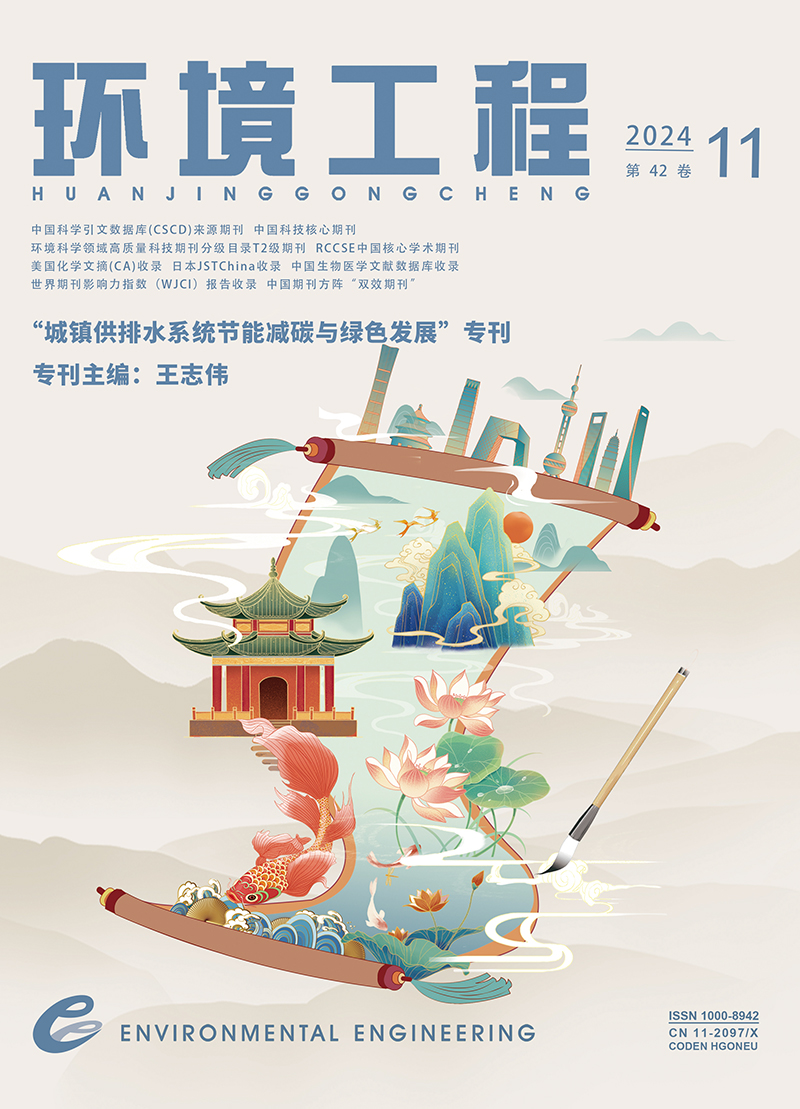| [1] |
HUANG Y J, MENG F L, LIU S M. China’s enhanced urban wastewater treatment increases greenhouse gas emissions and regional inequality[J]. Water Research,2023,230:536-547.
|
| [2] |
蒋彬,刘中亚,陈垚,等.碳中和视角下污水处理现状与展望[J]. 工业水处理,2022,42(6):51-58.
|
| [3] |
闫旭,邱德志,郭东丽,等.中国城镇污水处理厂温室气体排放时空分布特征[J]. 环境科学,2018, 39(3):1256-1263.
|
| [4] |
邱德志,陈纯,郭丽,等.基于排放因子法的中国主要城市群城镇污水厂温室气体排放特征[J]. 环境工程,2022,40(6):116-122.
|
| [5] |
钱晓雍,胡静,李丹,等.上海城镇污水处理厂温室气体排放核算及其特征[J]. 中国给水排水,2022,38(21):39-44.
|
| [6] |
XI J R, GONG H, ZHANG Y J. The evaluation of GHG emissions from Shanghai municipal wastewater treatment plants based on IPCC and operational data integrated methods (ODIM)[J]. Science of The Total Environment, 2021,797:967-976.
|
| [7] |
SU Q,DAI H C,XIE S Y. Water-energy-carbon nexus: greenhouse gas emissions from integrated urban drainage systems in China[J]. Environmental Science & Technology,2023,57:2093-2104.
|
| [8] |
陆家缘. 中国污水处理行业碳足迹与减排潜力分析[D].合肥:中国科学技术大学,2019.
|
| [9] |
EIJO-RIO E, PETIT-BOIX A, VILLALBA G. Municipal sewer networks as sources of nitrous oxide, methane and hydrogen sulphide emissions: a review and case studies[J]. Journal of Environmental Chemical Engineering,2015,3(3):2084-2094.
|
| [10] |
SONG M J, CHOI S, BAE W B. Identification of primary effecters of N2O emissions from full-scale biological nitrogen removal systems using random forest approach[J]. Water Research,2020,184:116-144.
|
| [11] |
BEAULIEU J J, TANK J L, HAMILTON S K. Nitrous oxide emission from denitrification in stream and river networks[J]. Proceedings of the National Academy of Sciences,2011,108(1):214-219.
|
| [12] |
张岳,葛铜岗,孙永利,等.基于城镇污水处理全流程环节的碳排放模型研究[J].中国给水排水, 2021,37(9):65-74.
|
| [13] |
赵刚,唐建国,徐竟成.中美典型污泥处理处置工程能耗和碳排放比较分析[J]. 环境工程,2022,40(12):9-16.
|
| [14] |
李哲坤,张立秋,杜子文,等.城市污泥不同处理处置工艺路线碳排放比较[J]. 环境科学,2023,44(2):1181-1190.
|
| [15] |
林文聪,赵刚,刘伟,等.污水厂污泥典型处理处置工艺碳排放核算研究[J]. 环境工程,2017,35(7):175-179.
|
| [16] |
SHORT M D, DAIKELER A, PETERS G M. Municipal gravity sewers: an unrecognised source of nitrous oxide[J]. Science of the Total Environment, 2014,468/469:211-218.
|
| [17] |
FOLEY J, YUAN Z, LANT P. Dissolved methane in rising main sewer systems: field measurements and simple model development for estimating greenhouse gas emissions[J]. Water Science and Technology, 2009,60(11):2963-2971.
|
| [18] |
LIU Y, NI B J, GANIGUE R. Sulfide and methane production in sewer sediments[J]. Water Research, 2015,70:350-359.
|
| [19] |
MANNINA G, BUTLER D, BENEDETTI L. Greenhouse gas emissions from integrated urban drainage systems: where do we stand?[J]. Journal of Hydrology,2018,559:307-314.
|
| [20] |
YAN X, LI L, LIU J X. Characteristics of greenhouse gas emission in three full-scale wastewater treatment processes[J]. Journal of Environmental Sciences (China), 2014,26(2):256-263.
|
| [21] |
SU Q, DAI H, XIE S. Water-energy-carbon nexus: greenhouse gas emissions from integrated urban drainage systems in China[J]. Environmental Science & Technology, 2023,57(5):2093-2104.
|
| [22] |
YANG M, PENG M, WU D, et al. Greenhouse gas emissions from wastewater treatment plants in China: historical emissions and future mitigation potentials[J]. Resources, Conservation and Recycling, 2023,190:106794.
|
| [23] |
KOSONEN M, HEINONEN H F, HEINONEN M. Nitrous oxide production at a fully covered wastewater treatment plant: results of a long-term online monitoring campaign[J]. Environmental Science & Technology, 2016,11(50): 5547-5554.
|
| [24] |
ZHAO X, JIN X K, GUO K. China’s urban methane emissions from municipal wastewater treatment plant[J]. Earth’s Future, 2019,7(4):480-490.
|
| [25] |
HUA H, JIANG S Y, YUAN Z W. Advancing greenhouse gas emission factors for municipal wastewater treatment plants in China[J]. Environmental Pollution, 2022,295:118648.
|
| [26] |
LIU B, WEI Q, ZHANG B. Life cycle GHG emissions of sewage sludge treatment and disposal options in Tai Lake Watershed, China[J]. Science of the Total Environment, 2013,447:361-369.
|
| [27] |
PAN Y T, LI Y, AKKER B. Sludge-drying lagoons: a potential significant methane source in wastewater treatment plants[J]. Environmental Science & Technology, 2016,50(3):1368-1375.
|
| [28] |
ZHU Y, ZHAO Y C, LI H J. Predictive method research of sludge landfill gas production[J]. China Environmental Science,2010,30:204-208.
|
| [29] |
BROWN S, BEECHER A, CARPENTER A. Calculator tool for determining greenhouse gas emissions for biosolids processing and end use[J]. Environmental Science & Technology, 2010,44 (24):9509-9515.
|
| [30] |
HU M P, CHEN D J, RANDY D. Modeling nitrous oxide emission from rivers: a global assessment[J]. Global Change Biology, 2016,22(11):3566-3582.
|
| [31] |
HU B B, WANG D Q, ZHOU J. Greenhouse gases emission from the sewage draining rivers[J]. Science of The Total Environment, 2018,612:1454-1462.
|
| [32] |
LIU X L, BAI L, WANG Z L. Nitrous oxide emissions from river network with variable nitrogen loading in Tianjin, China[J]. Journal of Geochemical Exploration,2015,157:153-161.
|
| [33] |
WANG J N, CHEN N W, YAN W J. Effect of dissolved oxygen and nitrogen on emission of N2O from rivers in China[J]. Atmospheric Environment, 2015,103:347-356.
|
| [34] |
GONZALEZ-VALENCIA R, SEPULVEDA-JAUREGUE A, MARTINEZ-CRUZ K. Methane emissions from Mexican freshwater bodies: correlations with water pollution[J]. Hydrobiologia, 2014,721(1):9-22.
|
| [35] |
于胜民.中国区域电网基准线排放因子[R]. 北京:生态环境部,2022.
|
| [36] |
SINGH P, KANSAL A, CARLIELL-MARQUET C. Energy and carbon footprints of sewage treatment methods[J]. Journal of Environmental Management, 2016,165:22-30.
|
| [37] |
张海亚, 王玉龙,李思琦, 等. 城镇污水处理厂碳排放现状及减污降碳协同增效路径探讨[J]. 环境工程技术学报,2023,13(6): 2053-2062.
|
| [38] |
胡香,陈孔明,李涛,等.巢湖流域城镇污水处理厂温室气体排放特征分析[J]. 环境污染与防治,2022,44(10):1409-1414.
|
| [39] |
石肖扬. 西安市污水处理厂减排效果及影响因素分析[D].西安:长安大学,2022.
|


 Login
Login Register
Register E-alert
E-alert






 DownLoad:
DownLoad: